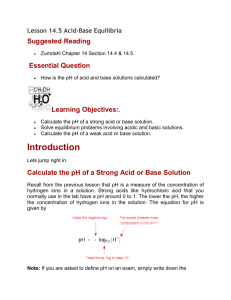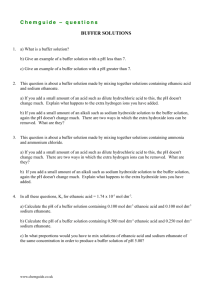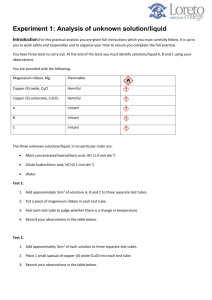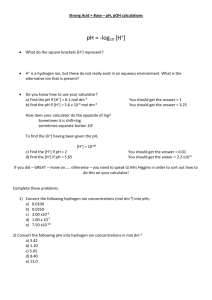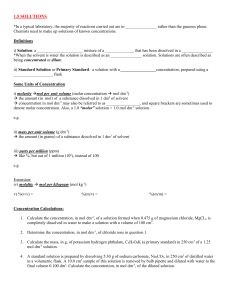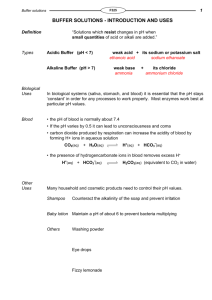3 Acids, Bases, and Buffers
advertisement
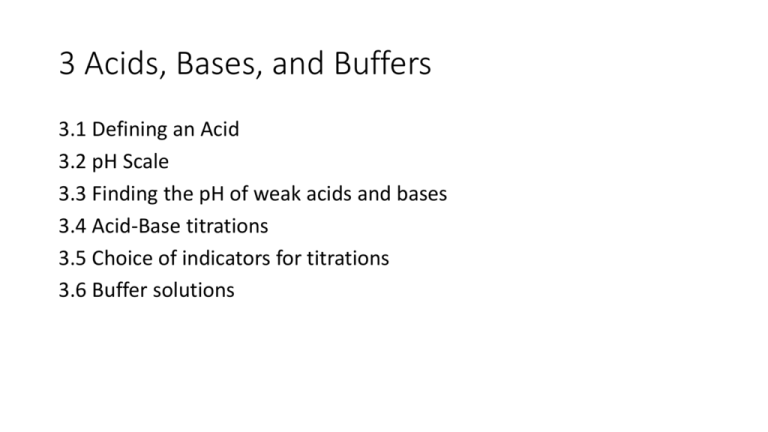
3 Acids, Bases, and Buffers 3.1 Defining an Acid 3.2 pH Scale 3.3 Finding the pH of weak acids and bases 3.4 Acid-Base titrations 3.5 Choice of indicators for titrations 3.6 Buffer solutions 3.1 Defining an acid Learning Objectives: 1. Describe a Bronsted-Lowry acid and base. 2. Describe what happens in Bronsted-Lowry acid-base reactions. 3. Describe how water acts as an acid and a base. 4. Understand the expression for the ionic product of water (Kw) Bronsted-Lowry Acid and Base Definitions • Acid – substance that donates a proton (H+) • Base – substance that can accept a proton (Alkali – a water soluble base producing OH- ions) • Examples: • Acids: HCl, H2SO4, HNO3 • Bases: NaOH, NH3 Equilibrium • The dissociation of acids is a reversible reaction in equilibrium. HA H + + A• For strong acids, the equilibrium lies heavily to the right. HCl H+ + Cl• For weak acids, the equilibrium lies heavily to the left. CH3COOH H+ + CH3COO- Acids and Bases react in pairs • A Bronsted-Lowry acid-base reaction involves a proton transfer. HA + B HB+ + A• Examples: HCl + NH3 NH4+ ClH2SO4 + HNO3 H2NO3+ + HSO4- Water as an acid and a base • Water can both donate and accept protons, so can act as both a Bronsted-Lowry acid and base. HCl + H2O H3O+ + ClH2O + NH3 NH4+ + OH- Ionisation of water • Water is ionised as it partially dissociates: H2O H+ + OHH2O + H2O H3O+ + OH• Water is a very weak acid/base so only partially dissociates. • The equilibrium lies heavily to the left and it is assumed that the concentration of water remains constant. Ionic Product of Water (Kw) • An equilibrium is established, with a Kc expression as follows: • Because [H2O] is assumed to be a constant, we modify the expression where Kw = Kc x [H2O] Ionic Product of Water (Kw) • Since H2O H+ + OH• For every water molecule, one H+ ion and one OH- ion is produced. • So we can use the expression Kw = [H+][OH-] Kw = [H+]2 3.2 The pH Scale Learning Objectives: 1. Define pH. 2. Use the pH to find the concentration of H+ and OH- ions. 3. Calculate pH from concentration of ions. pH scale pH = -log10[H+] • Why is a logarithmic scale used? • Because the [H+] varies so greatly the logarithmic scale helps us to use numbers that are more manageable. • What does this mean? • This means that a pH of 2 is 10X more acidic than a pH of 3. Try this out, Calculating pH from + [H ] • pH = -log[H+] • Calculate the pH for the following [H+] to see how this works: • 1.0 x 10 -1 mol dm-3 • 1.0 x 10 -7 mol dm-3 • 1.0 x 10 -14 mol dm-3 As [H+] increases, the pH… Review logs Kw changes with temperature, so pH of water also changes with temperature T (°C) Kw (mol2 dm-6) pH 0 0.114 x 10-14 7.47 10 0.293 x 10-14 7.27 20 0.681 x 10-14 7.08 25 1.008 x 10-14 7.00 30 1.471 x 10-14 6.92 40 2.916 x 10-14 6.77 50 5.476 x 10-14 6.63 100 51.3 x 10-14 6.14 Calculating + [H ] from pH Calculating [OH ] (extra step) pH of STRONG acids • For strong acids we make the assumption • STRONG ACIDS DISSOCIATE COMPLETELY. • Therefore: [HA] = [H+] • Calculate the pH of a solution with HCl concentration of: • 1.00 mol dm-3 • 0.160 mol dm-3 • 0.050 mol dm-3 • Calculate the pH of a solution with HCl concentration of: • 1.00 mol dm-3 pH 0.00 • 0.160 mol dm-3 pH 0.80 • 0.050 mol dm-3 pH 1.30 pH of STRONG bases • We make a similar assumption for bases, they dissociate fully. • NaOH Na+ + OH• Therefore… [NaOH] = [OH-] • We can then use the Kw equation to solve for [H+] Kw = [H+][OH-] Calculate the pH of alkaline solution • [NaOH] = a) 1.00 mol dm-3 b) 0.100 mol dm-3 c) 0.200 mol dm-3 a) 14 b) 13 c) 13.30 3.3 Finding the pH of weak acids and bases Learning objectives: 1) Describe what is meant by the term “weak acid” or “weak base” 2) Calculate the pH of weak acids and weak bases Weak acids and bases dissociation equilibrium HA H + + A- • Equilibrium expression + Kc = − 𝐻 [𝐴 ] [𝐻𝐴] Just another constant… • For weak acids this is given the symbol Ka • So… + Ka = − 𝐻 [𝐴 ] [𝐻𝐴] Calculating the pH of weak acids • This is very similar to our equilibrium calculations from before • Calculate the pH of 1.00 mol dm-3 ethanoic acid. CH3COOH CH3COO- + H+ • Start 1.00 0 0 • Eqm 1 – [CH3COO-] [CH3COO-] [H+] New assumptions 1) For each CH3COOH that dissociates, 1 CH3COO- and 1 H+ are produced • Therefore: [CH3COO-] = [H+] 2) Then 1 – [CH3COO-] = 1 – [H+] 3) For weak acids the dissociation is so small that 1.00 – [H+] = ~ 1.00 So…using the Ka expression − Ka = + 𝐶𝐻3𝑂𝑂 [𝐻 ] − 1.00−[𝐶𝐻3𝐶𝑂𝑂 ] This simplifies (from our assumptions) to… + Ka = 𝐇 𝟐 𝟏.𝟎𝟎 Then we look up the Ka, plug it in, and solve for [H+] Now you try it! • Find the pH of a 0.020 mol dm-3 solution of propanoic acid (CH3CH2COOH) at 298 K. Ka for this temperature is 1.30 x 10-5 mol dm-3. • 3.29 We can also work backwards • The pH of an ethanoic acid solution (CH3COOH) is 3.02 at 298 K. Calculation the concentration of this solution. The Ka of ethanoic acid is 1.75 x 10-5 mol dm-3 at 298 K. • (HINT: the inverse of log is 10x). • 5.21 x 10-2 mol dm-3 pKa (it’s like pH) • Ka numbers can vary greatly depending on the acid, so to make things easier and use more manageable numbers scientists often use pKa to compare acids easily. pKa = -log10(Ka) • The smaller the pKa is, the stronger the acid is (just like pH) • Just to make your life harder, sometimes pH calculations give you pKa and you have to convert into Ka to solve. 3.4 Acid-Base Titrations Learning Objectives: 1. Understand the uses of titrations 2. Identify and describe the shapes for pH curves for titrations 3. Describe the equivalence point of a titration Titrations are used to experimentally determine the amount of acid or alkali • Acid (of known concentration) is added or an alkali (or alkali can be added to acid) until an indicator shows that the alkali has been completed neutralised. • The amount of alkali (or acid) can then be calculated using the amount of the known acid (or alkali). titration curves (pH curves) • pH curves show the results of titration experiments. • X-axis = volume of titre • Y-axis = pH • The shape of the curve looks different depending on the strengths of the acid or alkali. pH curves Equivalence Point • Equivalence point is when the moles of alkali = the moles of (initial) H+ • This is represented by the vertical portion of the titration curve Equivalence point DOES NOT always = pH 7 Review: working out concentrations • In a titration, we find that the equivalence point is reached when 25 cm3 of 0.0150 mol dm-3 sodium hydroxide is neutralised by 15.0 cm3 hydrochloric acid. What is the concentration of the acid? Diprotic acids: Don’t forget the ratio! • In a titration we find that the equivalence point is reached when 20 cm3 of 0.0100 mol dm-3 sodium hydroxide is neutralised by 15.0 cm3 of sulphuric acid. What is the concentration of the acid? 3.5 Choice of indicators for titrations Learning Objectives: 1. Explain how to select a suitable indicator for a titration using the titration curve 2. Describe the importance of the half-neutralisation point. Suitable indicator must: 1) Sharp colour change 2) Distinct colour change 3) pH causing colour change must match the equivalence point End point of a titration • End point = the volume of titrate when the indicator just changes colour • Each indicator has a slightly different pH range leading to a colour change. • This range is acceptable because the vertical region of the titration curve shows how a very small change in volume leads to a large change in pH. Which indicator is suitable for this titration? The half-neutralisation point • The first part of a pH curve is very gently sloping, large volume changes lead to very small pH changes. • The mid-point between zero and the equivalence point is called the half-neutralisation point. • This is important because the knowledge that we can add a acid (or base) up to this point with very little change in pH is relevant to the theory of buffers. Also allows us to calculate Ka and pKa • HA + OH- H2O + A• At half-neutralisation point • [HA] = [A-] 3.6 Buffers Learning Objectives: 1) Describe what a buffer is. 2) Describe how buffers work. 3) Calculate the pH of a buffer solution. 4) Describe what buffers are used for. What is a buffer? • Buffer = a solution that resists changes in pH when small amounts of acid or alkali are added. • It DOES NOT stop the pH from changing, but it does make the changes smaller. • Buffers only resist changes from SMALL amounts of acid or alkali. How does a buffer work? • Buffers take advantage of Le Chatelier’s principle for equilibrium. • An equilibrium is set up with a weak acid or base with an excess of it’s conjugate salt. • When acid or alkali is added, it changes the concentration. This shift equilibrium which removes some of the excess H+ or OH- ions. Acidic Buffers • Made by mixing a weak acid with one of its (soluble) salts. • Example: Ethanoic acid + Sodium Ethanoate • CH3COOH CH3COO- + H+ • CH3COONa CH3COO- + Na+ • There is now only a small amount of H+ concentration and a large amount of CH3COO- in solution. What happens when we add acid? • CH3COOH CH3COO- + H+ • When acid is added what happens to this equilibrium? • [H+] increases, shifting equilibrium to the left to oppose the change. • There is plenty of CH3COO- (from the salt) for the reverse reaction (H+ combines with CH3COO-). • This produces more ethanoic acid and consequently decreases the [H+] back to near what it was before. What happens when we add alkali? • CH3COOH CH3COO- + H+ • What happens when we add alkali? • OH- ions react with H+ ions in solution (OH- + H+ H2O) • This decreases the [H+], so equilibrium shifts to the right. • There is plenty of ethanoic acid which dissociates to product more H+. • This then increases [H+] back to near what it was before. Basic Buffers • Similar concept, we mix a weak base with one of its (soluble) salts. • Example: Ammonia and Ammonium Chloride • NH3 + H2O • NH4Cl NH4+ + Cl- NH4+ + OH- What happens when you add acid? • NH3 + H2O NH4+ + OH- • H+ reacts with OH-, this decreases [OH-] • Equilibrium shifts to the right to replace [OH-] that has been lost. • This increases [OH-] back to near original. What happens when you add alkali? • NH3 + H2O NH4+ + OH- • [OH-] increases, so equilibrium shifts to the left. • This decreases the [OH-] near to original. Calculating the pH of acidic buffers 1) 2) 3) 4) 5) Write out the Ka expression for the weak acid. Rearrange to solve for [H+] Substitute in values for Ka, [weak acid], [salt] Solve for [H+] Substitute in [H+] into pH expression Example: • A buffer solution contains 0.400 mol dm-3 methanoic acid, HCOOH, and 0.600 mol dm-3 sodium methanoate, HCOONa. For methanoic acid, Ka = 1.6 x 10-4. What is the pH of this buffer solution? Try it! • A buffer consists of 0.100 mol dm-3 ethanoic acid and 0.100 mol dm-3 sodium ethanoate. Ka for ethanoic acid is 1.7 x 10-5, pKa = 4.77. What is the pH of the buffer solution? • 4.77 • Note: when you have equal amounts of acid and salt, pH = pKa (half-neutralisation point). Another way to make buffers • Sometimes a weak acid is mixed with a little alkali. This causes some of the acid to become neutralised forming the conjugate salt and some leftover acid. • To calculate the pH of this kind of buffer, an extra step is added. 1) Use the equation and molar ratios to calculate how many moles of acid and salt are left after neutralisation. 2) Calculate concentration using the total volume. 3) Calculate pH as before. • A buffer is formed by mixing 15 cm3 of 0.1 mol dm-3 sodium hydroxide and 30 cm3 of 0.6 mol dm-3 propanoic acid (CH3CH2COOH). Calculate the pH of this buffer solution (Ka = 1.35 x 10-5 mol dm-3). Calculating pH change when acid is added to an acidic buffer solution • This is similar to the equilibrium calculations. • Assumptions: • All the added H+ will react with the salt to form the weak acid. • So…the amount of ethanoic acid increases by amount acid added. • And…the amount of salt will decrease by the same amount. Calculating pH change of an acidic buffer 1) Calculate the starting amount (moles) of acid and salt. 2) Calculate the changes in moles of the acid and the salt. 3) Calculate the concentrations of the acid and the salt. 4) Substitute into Ka expression and solve for [H+]. 5) Calculate pH. • We start with a 1.00 dm3 buffer solution of ethanoic acid at concentration 0.10 mol dm-3 and sodium ethanoate at concentration 0.10 mol dm-3. Ka is 1.7 x 10-5 and pH is 4.77. • 10.0 cm3 of hydrochloric acid of concentration 1.00 mol dm-3 is added. What is the final pH of the solution? Calculating pH change when alkali is added to an acidic buffer solution • Assumptions: • All the added OH- will react with the H+ to form water. • This pushes the equilibrium to the right (more acid dissociates to form more H+ to replace what was lost) • So…the amount of ethanoic acid decreases by amount OH- added. • And…the amount of salt will increase by the same amount.

